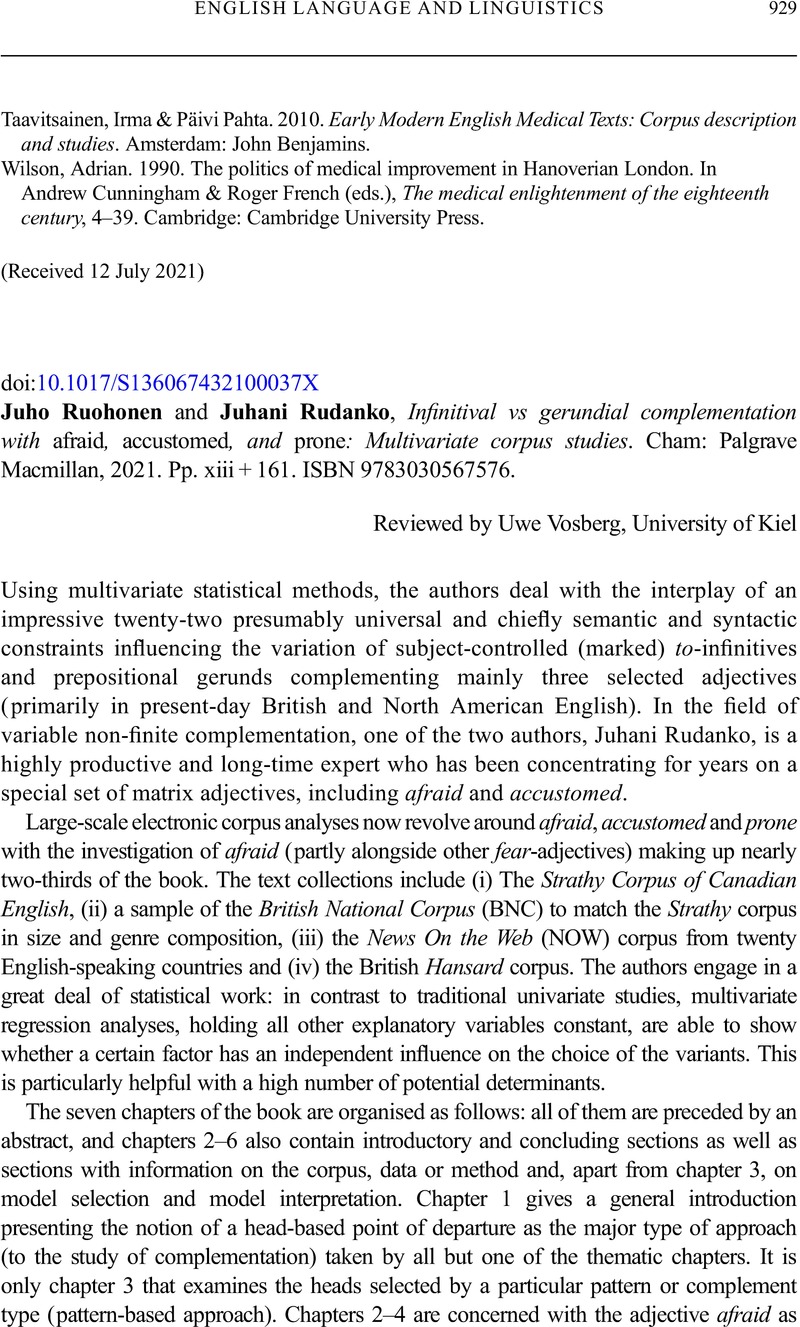No CrossRef data available.
Article contents
Juho Ruohonen and Juhani Rudanko, Infinitival vs gerundial complementation with afraid, accustomed, and prone: Multivariate corpus studies. Cham: Palgrave Macmillan, 2021. Pp. xiii + 161. ISBN 9783030567576.
Review products
Juho Ruohonen and Juhani Rudanko, Infinitival vs gerundial complementation with afraid, accustomed, and prone: Multivariate corpus studies. Cham: Palgrave Macmillan, 2021. Pp. xiii + 161. ISBN 9783030567576.
Published online by Cambridge University Press: 12 May 2022
Abstract
An abstract is not available for this content so a preview has been provided. Please use the Get access link above for information on how to access this content.

- Type
- Book Review
- Information
- Copyright
- Copyright © The Author, 2022. Published by Cambridge University Press
References
Rohdenburg, Günter. 1998. Attributive adjectives like similar and different involving prepositional complements. In Kühlwein, Wolfgang (ed.), Language as structure and language as process. In honour of Gerhard Nickel on the occasion of his 70th birthday, 63–79. Trier: Wissenschaftlicher Verlag.Google Scholar
Rohdenburg, Günter. 2003. Cognitive complexity and horror aequi as factors determining the use of interrogative clause linkers in English. In Rohdenburg, Günter & Mondorf, Britta (eds.), Determinants of grammatical variation in English, 205–49. Berlin: Mouton de Gruyter.CrossRefGoogle Scholar
Rohdenburg, Günter. 2016. Testing two processing principles with respect to the extraction of elements out of complement clauses in English. English Language and Linguistics 20, 463–86.CrossRefGoogle Scholar
Rohdenburg, Günter. 2018. The use of optional complement markers in present-day English: The role of passivization and other complexity factors. In Kaunisto, Mark, Höglund, Mikko & Rickman, Paul (eds.), Changing structures: Studies in constructions and complementation (Studies in Language Companion Series 195), 129–49. Amsterdam and Philadelphia: John Benjamins.CrossRefGoogle Scholar
Rohdenburg, Günter & Schlüter, Julia. 2009. New departures. In Rohdenburg, Günter & Schlüter, Julia (eds.), One language, two grammars? Differences between British and American English, 364–423. Cambridge: Cambridge University Press.CrossRefGoogle Scholar
Schlüter, Julia. 2015. Rhythmic influence on grammar: Scope and limitations. In Vogel, Ralf & de Vijver, Ruben van (eds.), Rhythm in cognition and grammar: A Germanic perspective (Trends in Linguistics. Studies and Monographs 286), 179–205. Berlin: Mouton de Gruyter.CrossRefGoogle Scholar
Vosberg, Uwe. 2006. Die Große Komplementverschiebung: Außersemantische Einflüsse auf die Entwicklung satzwertiger Ergänzungen im Neuenglischen. Tübingen: Narr.Google Scholar
Vosberg, Uwe. 2009. Non-finite complements. In Rohdenburg, Günter & Schlüter, Julia (eds.), One language, two grammars? Differences between British and American English, 212–27. Cambridge: Cambridge University Press.Google Scholar
Vosberg, Uwe & Rohdenburg, Günter. 2019. The rivalry between far from being + predicative item and its counterpart omitting the copula in Modern English. In Claridge, Claudia & Bös, Birte (eds.), Developments in English historical morpho-syntax, 287–307. Amsterdam and Philadelphia: John Benjamins.CrossRefGoogle Scholar



